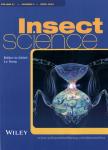Spruce budworm feeding and oviposition are stimulated by monoterpenes in white spruce epicuticular waxes
Spruce budworm feeding and oviposition are stimulated by monoterpenes in white spruce epicuticular waxes作者机构:Department of Biology Concordia University Montreal H4B 1R6 Department of Chemistry and Biochemistry Concordia University Montreal H4B 1R6 Departement des Sciences du bois et de la foret Universite Laval Quebec City Quebec Canada
出 版 物:《Insect Science》 (昆虫科学(英文版))
年 卷 期:2017年第24卷第1期
页 面:73-80页
核心收录:
学科分类:0907[农学-林学] 07[理学] 08[工学] 0829[工学-林业工程] 070602[理学-大气物理学与大气环境] 09[农学] 0706[理学-大气科学]
基 金:the Societe de Protection des Forets contre les Insectes et les Maladies du Quebec the Ministere des Ressources Naturelles et de la Faune du Quebec by the Natural Sciences and Engineering Research Council of Canada the Canadian Forest Service
主 题:Choristoneura fumiferana epicuticular waxes monoterpenes natural defense oviposition Picea glauca
摘 要:Monoterpenes, source of the distinctive odor of conifers, are generally considered plant defensive compounds. However, they are also known to act as long-range insect attractants, as they are volatile and permeate forest airspaces. Moreover, they are lipid soluble and can be absorbed into plant epicuticular waxes. We test their role in short-range host plant choice by both adult females and larvae of a folivorous forest pest (Choristoneura fumiferana). We conducted laboratory assays testing the responses of Eastern spruce budworm to an artificial monoterpene mix (α-pinene, β-pinene, limonene, myrcene) and to white spruce (Picea glauca) epicuticular waxes in closed arenas. Ovipositing females pre- ferred filter paper discs treated with P. glauca waxes to controls, and preferred the waxes + monoterpenes treatment to waxes alone. However, females showed no preference between the monoterpene-treated disc and the control when presented without waxes. Feeding larvae prefered wax discs to control discs. They also consumed discs treated with realistic monoterpene concentrations and wax preferentially over wax-only discs, but showed no preference between extremely high monoterpene concentrations and wax-only controls. In an insect-free assay, P. glauca epicuticular wax decreased monoterpene volatilization. These results suggest that P. glauca waxes and realistic concentrations of monoterpenes are stimulatory to both egg-laying females and feeding larvae, and that their effects are synergistic.



